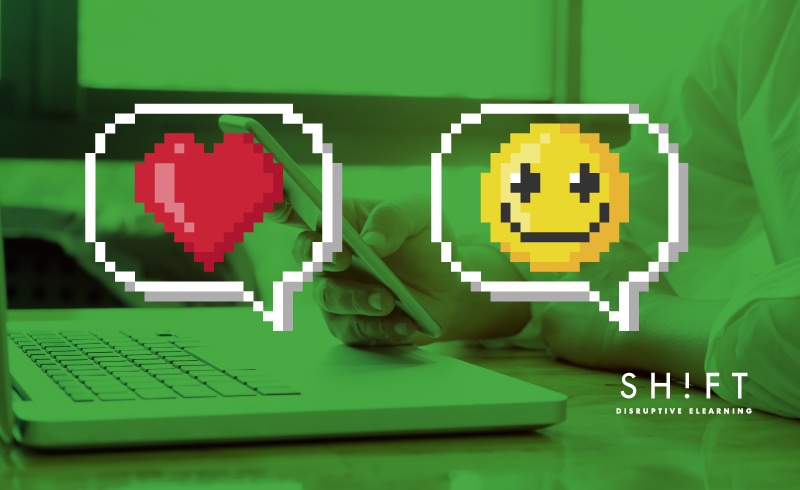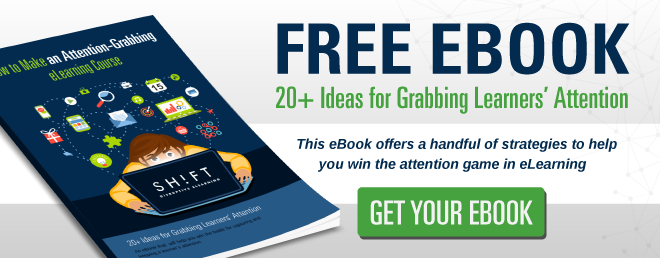It’s every instructional designer’s dream to design an eLearning course that will keep learner’s coming back for more. Furthermore, it’s your dream to have this course be instrumental in your team’s growth and development.
Achieving these results requires insightful strategies that merge content and design to entice the learner. It is also done by addressing their concerns and providing them with the information they need in ways they understand.
Review some of the triggers and strategies that will get your learners coming back for more much like gamers do. Read on about how to begin to incorporate them into your course lessons immediately!

1) Appetizing Content
As we all know, restaurants are a tough business and are incredibly tricky investments. For those who are unsure how difficult it is to achieve eLearning success, the failure rate is 60% failure rate, the same % restaurants that fail within the first year. According to Skillsoft and Towards Maturity report, this figure means that getting employees interested in is as tricky as keeping a restaurant in business. Tough crowd!
However, you’ll find relief in knowing that unlike the restaurant business, there are some strategies that you can apply once to keep yourself in business.
No, you won’t need to change your content, you will only need to improve the delivery of it. Think about trying to deliver bad news to someone? All that tweaking you do in your head. This exercise is similar.
Let’s face it. Your courses are assigned to your employees. Genuine interests aren’t at hand. However, you can make the experience an enjoyable one.
Here’re are some ideas on how to do that:
Idea #1: Allow binging
To keep the food metaphor going, let’s indulge in some binging!
Since advancements in technology, all media has catered to addictive behaviors. Seasons are released, not episodes. Books are downloaded immediately on your phone; you don’t even have to wait for it to arrive anymore. Therefore, when designing an e-learning initiative include a ‘binge’ option.
As an online platform, it makes sense to provide all content immediately. What’s the point of restraining people if they want to advance? Exactly!
Idea #2: “This is what you’ve been looking for!”
Have you ever stopped dead in your tracks when a brand claims to have "the answer" to a problem or concern? We all have. Using a “Recommendation” approach can make the learner feel that not only has the content been catered to their interest, but can be beneficial to their situation.
Idea #3: Serve it the right way
The next point to consider regarding content is how to set it up. How will you be serving this to your learners? Intelligently displaying content is the key. Here are some smarter ways to keep things on point:
- Flexibility: Furthermore, learning platforms should work similarly to Netflix in the way you can pause a show, log-off and later log-on again and resume your show right where you left off.
- Digestibility: Break down courses into bite-size chunks so that learners can make their way through training at a reasonable and self-directed pace, when and where they choose.
- Plan everything: How do people get hooked? There is an emotional component that fits into the narrative of your learners’ lives. Plan connections that your learner can find along the way. Keep them invested by anticipating the highs and lows and placing hooks in the right places.
Read more: What Do Modern Learners Actually Want From Your eLearning Courses?
Also read: The Rise of the Empowered Learner: 4 Things You Need to Know
2) Polish the User Experience
Imagine having a fabulous new stereo in your home. If it is challenging to set up, you’ll end up feeling confused and overwhelmed.
Will you be using it often? Probably not.
The quality of the experiences that we have usually dictate how often and how eagerly we will use them. That said, a clean, user-friendly eLearning design will probably be popular among learners.
This connection between student and content is because learning is an emotional experience, and it’s best to keep learner’s frustrations at bay. Learners need to access “other” options intuitively. Focusing too long on navigation questions pulls their attention away from the course altogether. If there were a space for addiction, this would most certainly break that.
The crème de la crème in eLearning won’t have differentiators between courses to regular entertainment. By using the same intuitive interface as consumer sites like Netflix, employers can apply the same addictive triggers to maintain learners keen on their courses and keep employees in their comfort zone.
Some factors to consider:
- Style: Find the sweet spot. Use vivid colors, readable fonts, and vibrant images/video.
- Consistency: Whatever icons you decide on and wherever you place them, keep them there. An interface becomes familiar to a learner from usage. Don’t make everything feel like the first time. If the next button is big, green, and to the left, keep it there throughout the course.
- Whitespace: Have you ever scanned all four sides of a box three times for a simple piece of information and still couldn’t find it? No one needs that much info, use whitespace. Keep it necessary, so the eye sees what it needs.
- Add Flair: Be innovative. Play with the structure to make advancing exciting. Things don’t always have to be as linear as “Next” and “Back.” You could create an exploratory styled course. Without being messy, allow creativity into the learning experience.
- Think Mobile: As mentioned above, allowing learners to access content whenever and however they want is required these days. But aside from making it accessible, you’ll also want to make it readable. Make sure that your content is responsive to any device. If students are open to mobile eLearning, don’t push them away.
Remember, the quality of the experience is notable mostly because it doesn’t hold the learner back. Stick to these principles to avoid negative feelings between your course and your learners.
Also read: The Questions You Must Ask to Build the Best User Experience In Your eLearning Course
3) Checks All The Way Home
Have you ever been on the verge of closing out of Netflix only to realize that you just had two episodes to go? We all have. Checklists have a way of keeping us invested, and it works for eLearning courses as well.
Measuring our progress and feeling accomplished is a natural human desire. Learners want to feel the support of a lattice type network of supporters and support systems so that their motivation is not lost to frustration. This includes design elements that reinforce positive growth and steps forward towards the goal as the learner progresses.Your eLearning courses should always provide opportunities for challenge and success that keep the learner moving forward, and feedback so that the learner knows what he’s doing right or wrong.
Incorporate a checklist or even add gamification elements like “progress bars” into your structure to help guide your learner’s in their development and persuade them to advance and complete the course.
Here are some things that motivate learners to continue that you’ll want to include when you design your course features:
- How much time does it take a student to complete a lesson?
- How much time does it take a student to complete the course?
- List of achieved/learned tasks at the end of every lesson
- How much time have they invested overall (as they go)?
These indicators will not only motivate them but encourage them complete the task in a timely fashion.
Some self-reflection questions:
- How can you create a positive expectation for success since the beginning of the course?
- How can you make learners feel confident that they can achieve their goals?
- How can you make learning requirements seem realistic and achievable?
- How can you demonstrate learners their success is based upon their hard work?
Read more: The Basics of Motivational eLearning Design
4) It Takes a Village
Have you ever clicked on the column “Users Also Purchased This Item” next to your shopping cart? We’re addicted to knowing things about each other, interacting, and bonding with like-minded peers.
We’re a curious bunch, and we are open up to what others are doing. This need to connect is why a community helps nurture the learning experience. It allows learners to communicate with challenges, questions, and real-life scenarios. You can gather some ideas from traditional classrooms and incorporate Q&A’s, discussion forums and social media to encourage learners to interact with instructors and each other. By using these social tools, you are inspiring empathy and creativity as opposed to passive listening. This allows learners to engage more, retain more and overall get more from you courses.
Two reasons that a community can upgrade your eLearning course can be:
- State each learner’s progress where others can follow. Much like the fitness sharing apps, this can motivate everyone to complete their lessons and reach the goal. The public aspect of learning can be a rewarding one when others can endorse skills and encourage each other via their profiles.
- Create a conversation that can snowball all on its own depending on interests, opinions, and concerns.
This sense of community is incredibly alluring to learners as social beings. Include it and watch them engage with your course!
Read more: What We’ve Learned from Creating Over 2,000 E-Learning Courses
It’s every instructional designer’s dream to design an eLearning program that would keep learner’s coming back for more. Achieving this at times feel more like luck than anything else, but it’s not. There are tricks. Start applying some of these learner’s focused insights now to get your end user hook on your course, today!







